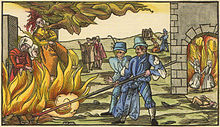Moral panic
feeling of fear spread among a large number of people that some evil threatens the well-being of society
Moral panic is when a category or group of people is seen as a threat to the moral values of society. The people who are seen as a threat show certain patterns of behaviour which are seen as problematic. The goal of the moral panic is to stop these problematic behaviours. In modern times, a sensationalist reporting of the press, and privately organized actions often accompany moral panics.

In the end, a moral panic will lead to an increase in social control; the chances that values change in a normal way will decrease.[1]
Moral panic is different from mass hysteria. With mass hysteria, there is no social control.
Examples
change- From about the 1920s, different kinds of new music have been said to cause spiritual or otherwise moral corruption to younger generations.[2] These were sometimes called "the devil's music". Blues recived this label; people believed it caused people to become violent, and to show other poor behavior. Jazz also received such a label; traditionalists considered jazz to contribute to the breakdown of morality.[3] Blues and jazz were seen as "negro music" . Urban middle-class African Americans perceived jazz as "devil's music", and agreed with the beliefs that jazz's improvised rhythms and sounds were promoting promiscuity.[4] In the mid 1980s, teenagers had killed themselves after they had listened to music for some time; mostly metal. A label "Parental advisory:explicit lyrics" was introduced, but court cases to sue musicians because of the texts they used were unsuccessful.[5] A group of parents were discontent, because the parental advisory sticker would not make a difference between music that was "offensive, satanic, sexual in nature [or] otherwise objectionable."[5]
- In Canada, discussion on what was called reasonable accomodation.
- In France, people opposing same-sex marriage; also discussion on the sexuality of adolescents.[6]
- In certain western countries, the ways of fighting against pedophilia.
References
change- ↑ Kenneth Thompson: Why the Panic? – The History and Meaning of the Concept. In: Moral Panics. Routledge, New York 1998, S. 1–22.
- ↑ "Suicide, Rock Music and Moral Panics". Centre for Suicide Prevention. Retrieved 2021-06-02.
- ↑ Fass, Paula (1977). The damned and the beautiful : American youth in the 1920's. New York: Oxford University Press. p. 22. ISBN 978-0-19-502148-6.
- ↑ Dinerstein, Joel (2003). "Music, Memory, and Cultural Identity in the Jazz Age". American Quarterly. 55 (2): 303–313. doi:10.1353/aq.2003.0012. S2CID 145194943.
- ↑ 5.0 5.1 "Mathieu Deflem: Popular Culture and Social Control: The Moral Panic on Music Labeling". Mathieu Deflem. Retrieved 2023-01-01.
- ↑ Bozon, Michel (2012-02-07). "Autonomie sexuelle des jeunes et panique morale des adultes". Agora débats/Jeunesses (in French). No. 60: 121–134. doi:10.3917/agora.060.0121. ISSN 1268-5666.
{{cite journal}}:|volume=has extra text (help)